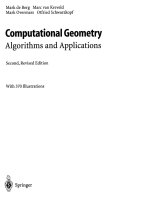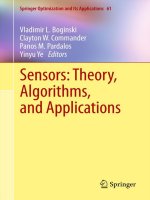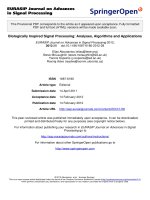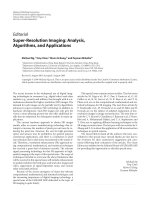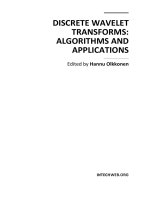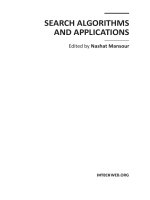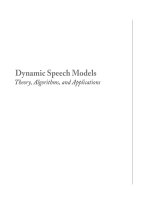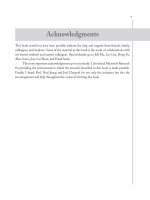Sparse dimensionality reduction methods algorithms and applications
Bạn đang xem bản rút gọn của tài liệu. Xem và tải ngay bản đầy đủ của tài liệu tại đây (1.27 MB, 178 trang )
SPARSE DIMENSIONALITY REDUCTION
METHODS: ALGORITHMS AND
APPLICATIONS
ZHANG XIAOWEI
(B.Sc., ECNU, China)
A THESIS SUBMITTED
FOR THE DEGREE OF DOCTOR OF PHILOSOPHY
DEPARTMENT OF MATHEMATICS
NATIONAL UNIVERSITY OF SINGAPORE
JULY 2013
To my parents
DECLARATION
I hereby declare that the thesis is my original work and it has been written by me in
its entirety. I have duly acknowledged all the sources of information which have been used
in the thesis.
This thesis has also not been submitted for any degree in any university previously.
Zhang Xiaowei
July 2013
Acknowledgements
First and foremost I would like to express my deepest gratitude to my supervisor, As-
sociate Professor Chu Delin, for all his guidance, support, kindness and enthusiasm
over the past five years of my graduate study at National University of Singapore.
It is an invaluable privilege to have had the opportunity to work with him and learn
many wonderful mathematical insights from him. Back in 2008 when I arrived at
National University of Singapore, I knew little about the area of data mining and
machine learning. It is Dr. Chu who guided me into these research areas and en-
couraged me to explore various ideas, and patiently helped me improve how I do
research. It would not have been possible to complete this doctoral thesis without
his support. Beyond being an energetic and insightful researcher, he also helped me
a lot on how to communicate with other people. I feel very fortunate to be advised
by Dr. Chu.
I would like to thank Professor Li-Zhi Liao and Professor Michael K. Ng, both
from Hong Kong Baptist University, for their assistance and support in my research.
Interactions with them were very constructive and helped me a lot in writing this
thesis.
I am greatly indebted to National University of Singapore for providing me a
full scholarship and an exceptional study environment. I would also like to thank
v
vi Acknowledgements
Department of Mathematics for providing financial support for my attendance of
IMECS 2013 in Hong Kong and ICML 2013 in Atlanta. The Centre for Computa-
tional Science and Engineering provides large-scale computing facilities which enable
me to conduct numerical experiments in my thesis.
I am also grateful to all friends and collaborators. Special thanks go to Wang
Xiaoyan and Goh Siong Thye, with whom I closely worked and collaborated. With
Xiaoyan, I shared all experience as a graduate student and it was enjoyable to discuss
research problems or just chat about everyday life. Siong Thye is an optimistic man
and taught me a lot about machine learning, and I am more than happy to see that
he continues his research at MIT and is working to become the next expert in his
field.
Last but not least, I want to warmly thank my family, my parents, brother and
sister, who encouraged me to pursue my passion and supported my study in every
possible way over the past five years.
Contents
Acknowledgements v
Summary xi
1 Introduction 1
1.1 Curse of Dimensionality . . . . . . . . . . . . . . . . . . . . . . . . . 2
1.2 Dimensionality Reduction . . . . . . . . . . . . . . . . . . . . . . . . 4
1.3 Sparsity and Motivations . . . . . . . . . . . . . . . . . . . . . . . . . 7
1.4 Structure of Thesis . . . . . . . . . . . . . . . . . . . . . . . . . . . . 9
2 Sparse Linear Discriminant Analysis 11
2.1 Overview of LDA and ULDA . . . . . . . . . . . . . . . . . . . . . . 12
2.2 Characterization of All Solutions of Generalized ULDA . . . . . . . . 16
2.3 Sparse Uncorrelated Linear Discriminant Analysis . . . . . . . . . . . 21
2.3.1 Proposed Formulation . . . . . . . . . . . . . . . . . . . . . . 22
2.3.2 Accelerated Linearized Bregman Method . . . . . . . . . . . . 24
2.3.3 Algorithm for Sparse ULDA . . . . . . . . . . . . . . . . . . . 29
vii
viii Contents
2.4 Numerical Experiments and Comparison with Existing Algorithms . . 31
2.4.1 Existing Algorithms . . . . . . . . . . . . . . . . . . . . . . . 32
2.4.2 Experimental Settings . . . . . . . . . . . . . . . . . . . . . . 35
2.4.3 Simulation Study . . . . . . . . . . . . . . . . . . . . . . . . . 36
2.4.4 Real-World Data . . . . . . . . . . . . . . . . . . . . . . . . . 38
2.5 Conclusions . . . . . . . . . . . . . . . . . . . . . . . . . . . . . . . . 43
3 Canonical Correlation Analysis 45
3.1 Background . . . . . . . . . . . . . . . . . . . . . . . . . . . . . . . . 46
3.1.1 Various Formulae for CCA . . . . . . . . . . . . . . . . . . . . 47
3.1.2 Existing Methods for CCA . . . . . . . . . . . . . . . . . . . . 49
3.2 General Solutions of CCA . . . . . . . . . . . . . . . . . . . . . . . . 51
3.2.1 Some Supporting Lemmas . . . . . . . . . . . . . . . . . . . . 53
3.2.2 Main Results . . . . . . . . . . . . . . . . . . . . . . . . . . . 57
3.3 Equivalent relationship between CCA and LDA . . . . . . . . . . . . 66
3.4 Conclusions . . . . . . . . . . . . . . . . . . . . . . . . . . . . . . . . 70
4 Sparse Canonical Correlation Analysis 71
4.1 A New Sparse CCA Algorithm . . . . . . . . . . . . . . . . . . . . . . 72
4.2 Related Work . . . . . . . . . . . . . . . . . . . . . . . . . . . . . . . 75
4.2.1 Sparse CCA Based on Penalized Matrix Decomposition . . . . 76
4.2.2 CCA with Elastic Net Regularization . . . . . . . . . . . . . . 78
4.2.3 Sparse CCA for Primal-Dual Data Representation . . . . . . . 78
4.2.4 Some Remarks . . . . . . . . . . . . . . . . . . . . . . . . . . 82
4.3 Numerical Results . . . . . . . . . . . . . . . . . . . . . . . . . . . . . 83
4.3.1 Synthetic Data . . . . . . . . . . . . . . . . . . . . . . . . . . 84
4.3.2 Gene Expression Data . . . . . . . . . . . . . . . . . . . . . . 87
Contents ix
4.3.3 Cross-Language Document Retrieval . . . . . . . . . . . . . . 93
4.4 Conclusions . . . . . . . . . . . . . . . . . . . . . . . . . . . . . . . . 99
5 Sparse Kernel Canonical Correlation Analysis 101
5.1 An Introduction to Kernel Methods . . . . . . . . . . . . . . . . . . . 102
5.2 Kernel CCA . . . . . . . . . . . . . . . . . . . . . . . . . . . . . . . . 104
5.3 Kernel CCA Versus Least Squares Problem . . . . . . . . . . . . . . . 108
5.4 Sparse Kernel Canonical Correlation Analysis . . . . . . . . . . . . . 114
5.5 Numerical Results . . . . . . . . . . . . . . . . . . . . . . . . . . . . . 120
5.5.1 Experimental Settings . . . . . . . . . . . . . . . . . . . . . . 120
5.5.2 Synthetic Data . . . . . . . . . . . . . . . . . . . . . . . . . . 121
5.5.3 Cross-Language Document Retrieval . . . . . . . . . . . . . . 123
5.5.4 Content-Based Image Retrieval . . . . . . . . . . . . . . . . . 127
5.6 Conclusions . . . . . . . . . . . . . . . . . . . . . . . . . . . . . . . . 130
6 Conclusions 133
6.1 Summary of Contributions . . . . . . . . . . . . . . . . . . . . . . . . 133
6.2 Future Work . . . . . . . . . . . . . . . . . . . . . . . . . . . . . . . . 135
Bibliography 137
A Data Sets 157
Summary
This thesis focuses on sparse dimensionality reduction methods, which aim to find
optimal mappings to project high-dimensional data into low-dimensional spaces and
at the same time incorporate sparsity into the mappings. These methods have many
applications, including bioinformatics, text processing and computer vision.
One challenge posed by high dimensionality is that, with increasing dimension-
ality, many existing data mining algorithms usually become computationally in-
tractable. Moreover, a lot of samples are required when performing data mining
techniques on high-dimensional data so that information extracted from the data
is accurate, which is well known as the curse of dimensionality. To deal with this
problem, many significant dimensionality reduction methods have been proposed.
However, one major limitation of these dimensionality reduction techniques is that
mappings learned from the training data lack sparsity, which usually makes in-
terpretation of the results challenging or computation of the projections of new
data time-consuming. In this thesis, we address the problem of deriving sparse
version of some widely used dimensionality reduction methods, specifically, Linear
Discriminant Analysis (LDA), Canonical Correlation Analysis (CCA) and its kernel
extension Kernel Canonical Correlation Analysis (kernel CCA).
xi
xii Summary
First, we study uncorrelated LDA (ULDA) and obtain an explicit characteriza-
tion of all solutions of ULDA. Based on the characterization, we propose a novel
sparse LDA algorithm. The main idea of our algorithm is to select the sparsest
solution from the solution set, which is accomplished by minimizing
1
-norm sub-
ject to a linear constraint. The resulted
1
-norm minimization problem is solved by
(accelerated) linearized Bregman iterative method. With similar idea, we investi-
gate sparse CCA and propose a new sparse CCA algorithm. Besides that, we also
obtain a theoretical result showing that ULDA is a special case of CCA. Numerical
results with synthetic and real-world data sets validate the efficiency of the proposed
methods, and comparison with existing state-of-the-art algorithms shows that our
algorithms are competitive.
Beyond linear dimensionality reduction methods, we also investigate sparse ker-
nel CCA, a nonlinear variant of CCA. By using the explicit characterization of
all solutions of CCA, we establish a relationship between (kernel) CCA and least
squares problems. This relationship is further utilized to design a sparse kernel
CCA algorithm, where we penalize the least squares term by
1
-norm of the dual
transformations. The resulted
1
-norm regularized least squares problems are solved
by fixed-point continuation method. The efficiency of the proposed algorithm for
sparse kernel CCA is evaluated on cross-language document retrieval and content-
based image retrieval.
List of Tables
1.1 Sample size required to ensure that the relative mean squared error
at zero is less than 0.1 for the estimate of a normal distribution . . . 3
2.1 Simulation results. The reported values are means (and standard
deviations), computed over 100 replications, of classification accuracy,
sparsity, orthogonality and total number of selected features. . . . . . 37
2.2 Data stuctures: data dimension (d), training size (n), the number of
classes (K) and the number of testing data (# Testing). . . . . . . . 39
2.3 Numerical results for gene data over 10 training-testing splits: mean
(and standard deviation) of classification accuracy, sparsity, orthog-
onality and the number of selected variables. . . . . . . . . . . . . . . 40
2.4 Numerical results for image data over 10 training-testing splits: mean
(and standard deviation) of classification accuracy, sparsity, orthog-
onality and the number of selected variables. . . . . . . . . . . . . . . 41
4.1 Comparison of results obtained by SCCA
1
with µ
x
= µ
y
= µ and
1
=
2
= 10
−5
, PMD, CCA EN, and SCCA PD. . . . . . . . . . . . . 87
xiii
xiv List of Tables
4.2 Data stuctures: data dimension (d
1
), training size (n), the number
of classes (K) and the number of testing data (# Testing), m is the
rank of matrix XY
T
, l is the number of columns in W
x
and W
y
and
we choose l = m in our experiments. . . . . . . . . . . . . . . . . . . 88
4.3 Comparison of classification accuracy (%) between ULDA and W
NS
x
of CCA using 1NN as classifier . . . . . . . . . . . . . . . . . . . . . 89
4.4 Comparison of results obtained by SCCA
1
, PMD, CCA EN, and
SCCA PD. . . . . . . . . . . . . . . . . . . . . . . . . . . . . . . . . . 90
4.5 Comparison of results obtained by SCCA
1
, PMD, CCA EN, and
SCCA PD. . . . . . . . . . . . . . . . . . . . . . . . . . . . . . . . . . 91
4.6 Average AROC of standard CCA and sparse CCA algorithms using
Data Set I (French to English). . . . . . . . . . . . . . . . . . . . . . 97
4.7 Average AROC of standard CCA, SCCA
1
and SCCA PD using
Data Set II (French to English). . . . . . . . . . . . . . . . . . . . . . 98
5.1 Computational complexity of Algorithm 7 . . . . . . . . . . . . . . . 120
5.2 Correlation between the first pair of canonical variables obtained by
ordinary CCA, RKCCA and SKCCA. . . . . . . . . . . . . . . . . . . 121
5.3 Cross-language document retrieval using CCA, KCCA, RKCCA and
SKCCA. . . . . . . . . . . . . . . . . . . . . . . . . . . . . . . . . . . 125
5.4 Content-based image retrieval using CCA, KCCA, RKCCA and SKCCA.129
List of Figures
2.1 2D visualization of the SRBCT data: all samples are projected onto
the first two sparse discriminant vectors obtained by PLDA (upper
left), SDA (upper right), GLOSS (lower left) and SULDA (lower
right), respectively. . . . . . . . . . . . . . . . . . . . . . . . . . . . . 42
4.1 True value of vectors v
1
and v
2
. . . . . . . . . . . . . . . . . . . . . . 85
4.2 W
x
and W
y
computed by different sparse CCA algorithms: (a) SCCA
1
(our approach), (b) Algorithm PMD, (c) Algorithm CCA EN, (d) Al-
gorithm SCCA PD. . . . . . . . . . . . . . . . . . . . . . . . . . . . . 86
4.3 Average AROC achieved by CCA and sparse CCA as a function of
the number of columns of (W
x
, W
y
) used: (a) Data Set I, (b) Data
Set II. . . . . . . . . . . . . . . . . . . . . . . . . . . . . . . . . . . . 96
5.1 Plots of the first pair of canonical variates:(a) sample data, (b) ordi-
nary CCA, (c) RKCCA, (d) SKCCA. . . . . . . . . . . . . . . . . . . 122
xv
xvi List of Figures
5.2 Cross-language document retrieval using CCA, KCCA, RKCCA and
SKCCA: (a) Europarl data with 50 training data, (b) Europarl data
with 100 training data,(c) Hansard data with 200 training data, (d)
Hansard data with 400 training data. . . . . . . . . . . . . . . . . . . 124
5.3 Gabor filters used to extract texture features. Four frequencies f =
1/λ = [0.15, 0.2, 0.25, 0.3] and four directions θ = [0, π/4, π/2, 3π/4]
are used. The width of the filters are σ = 4. . . . . . . . . . . . . . . 128
5.4 Content-based image retrieval using CCA, KCCA, RKCCA and SKCCA
on UW ground truth data with 217 training data. . . . . . . . . . . . 130
Chapter 1
Introduction
Over the past few decades, data collection and storage capabilities as well as data
management techniques have achieved great advances. Such advances have led to a
leap of information in most scientific and engineering fields. One of the most sig-
nificant reflections is the prevalence of high-dimensional data, including microarray
gene expression data [7, 51], text documents [12, 90], functional magnetic resonance
imaging (fMRI) data [59, 154], image/video data and high-frequency financial data,
where the number of features can reach tens of thousands. While the proliferation of
high-dimensional data lays the foundation for knowledge discovery and pattern anal-
ysis, it also imposes challenges on researchers and practitioners of effectively utilizing
these data and mining useful information from them, due to the high dimensionality
character of these data [47]. One common challenge posed by high dimensionality is
that, with increasing dimensionality, many existing data mining algorithms usually
become computationally intractable and therefore inapplicable in many real-world
applications. Moreover, a lot of samples are required when performing data mining
techniques on high-dimensional data so that information extracted from the data is
accurate, which is well known as the curse of dimensionality.
1
2 Chapter 1. Introduction
1.1 Curse of Dimensionality
The phrase ‘curse of dimensionality’, apparently coined by Richard Bellman in [117],
is used by the statistical community to describe the problem that the number of
samples required to estimate a function with a specific level of accuracy grows expo-
nentially with the dimension it comprises. Intuitively, as we increase the dimension,
most likely we will include more noise or outliers as well. In addition, if the samples
we collect are inadequate, we might be misguided by the wrong representation of
the data. For example, we might keep sampling from the tail of a distribution, as
illustrated by the following example.
Example 1.1. Consider a sphere of radius r in d dimensions together with the
concentric hypercube of side 2r, so that the sphere touches the hypercube at the
centres of each of its sides. The volume of the hypercube is (2r)
d
and the volume of
the sphere is
2r
d
π
d/2
dΓ(d/2)
, where Γ(·) is the gamma function defined by
Γ(x) =
∞
0
u
x−1
e
−u
du.
Thus, the ratio of the volume of the sphere to the volume of the cube is given by
π
d/2
d2
d−1
Γ(d/2)
, which converges to zero as d → ∞. We can see from this result that, in
high dimensional spaces, most of the volume of a hypercube is concentrated in the
large number of corners.
Therefore, in the case of a uniform distribution in high-dimensional space, most
of the probability mass is concentrated in tails. Similar behaviour can be observed for
the Gaussian distribution in high-dimensional spaces, where most of the probability
mass of a Gaussian distribution is located within a thin shell at a large radius [15].
Another example illustrating the difficulty imposed by high dimensionality is
kernel density estimation.
Example 1.2. Kernel density estimation (KDE) [20] is a popular method for esti-
mating probability density function (PDF) for a data set. For a given set of samples
1.1 Curse of Dimensionality 3
{x
1
, ··· , x
n
} in R
d
, the simplest KDE aims to estimate the PDF f(x) at a point
x ∈ R
d
with the estimation in the following form:
ˆ
f
n
(x) =
1
n
n
i=1
1
h
d
n
k
x − x
i
h
n
,
where h
n
=
1
n
d+4
is the bandwidth, k : [0, ∞) → [0, ∞) is a kernel function satisfying
certain conditions. Then the mean squared error in the estimate
ˆ
f
n
(x) is given by
MSE[
ˆ
f
n
(x)] = E[(
ˆ
f
n
(x) − f(x))
2
] = O
1
n
4/(d+4)
, as n → ∞.
Thus, the convergence rate slows as the dimensionality increases. To achieve the
same convergence rate with the case where d = 10 and n = 10, 000, approximately 7
million (i.e., n ≈ 7 ×10
6
) samples are required if the dimensionality is increased to
d = 20. To get a rough idea of the impact of sample size on the estimation error,
we can look at the following table, taken from Silverman [129], which illustrates how
the sample size required for a given relative mean squared error for the estimate of
a normal distribution increases with the dimensionality.
Table 1.1: Sample size required to ensure that the relative mean squared error at
zero is less than 0.1 for the estimate of a normal distribution
Dimensionality Required Sample Size
1 4
2 19
3 67
6 2790
10 842000
Although the curse of dimensionality draws a gloomy picture for high-dimensional
data analysis, we still have hope in the fact that, for many high-dimensional data in
practice, the intrinsic dimensionality [61] of these data may be low in the sense that
the minimum number of parameters required to account for the observed properties
of these data is much smaller. A typical example of this kind arises in document
classification [12, 96].
4 Chapter 1. Introduction
Example 1.3 (Text document data). The simplest possible way of representing a
document is as a bag-of-words, where a document is represented by the words it
contains, with the ordering of these words being ignored. For a given collection of
documents, we can get a full set of words appearing in the documents being processed.
The full set of words is referred as the dictionary whose dimensionality is typically in
tens of thousands. Each document is represented as a vector in which each coordinate
describes the weight of one word from the dictionary.
Although the dictionary has high dimensionality, the vector associated with a
given document may contain only a few hundred non-zero entries, since the document
typically contains only very few of the vast number of words in the dictionary. In
this sense, the intrinsic dimensionality of this data is the number of non-zero entries
in the vector, which is far smaller than the dimensionality of the dictionary.
To avoid the curse of dimensionality, we can design methods which depend
only on the intrinsic dimensionality of the data; or alternatively work on the low-
dimensional data obtained by applying dimensionality reduction techniques to the
high-dimensional data.
1.2 Dimensionality Reduction
Dimensionality reduction, aiming at reducing the dimensionality of original data,
transforms the high-dimensional data into a much lower dimensional space and at
the same time preserves essential information contained in the original data as much
as possible. It has been widely applied in many areas, including text mining, im-
age retrieval, face recognition, handwritten digit recognition and microarray data
analysis.
Besides avoiding the curse of dimensionality, there are many other motivations
for us to consider dimensionality reduction. For example, dimensionality reduction
can remove redundant and noisy data and avoid data over-fitting, which improves
1.2 Dimensionality Reduction 5
the quality of data and facilitates further processing tasks such as classification
and retrieval. The need for dimensionality reduction also arises for data compres-
sion in the sense that, by applying dimensionality reduction, the size of the data
can be reduced significantly, which saves a lot storage space and reduces computa-
tional cost in further processing. Another motivation of dimensionality reduction
is data visualization. Since visualization of high-dimensional data is almost beyond
the capacity of human beings, through dimensionality reduction, we can construct
2-dimensional or 3-dimensional representation of high-dimensional data such that
essential information in the original data is preserved.
In mathematical terms, dimensionality reduction can be defined as follows. As-
sume we are given a set of training data
A =
a
1
··· a
n
∈ R
d×n
consisting of n samples from d-dimensional space. The goal is to learn a mapping
f(·) from the training data by optimizing certain criterion such that, for each given
data x ∈ R
d
, f(x) is a low-dimensional representation of x.
The subject of dimensionality reduction is vast, and can be grouped into dif-
ferent categories based on different criteria. For example, linear and non-linear
dimensionality reduction techniques; unsupervised, supervised and semi-supervised
dimensionality reduction techniques. In linear dimensionality, the function f is lin-
ear, that is,
x
L
= f(x) = W
T
x, (1.1)
where W ∈ R
d×l
(l d) is the projection matrix learned from training data, e.g.,
Principal Component Analysis (PCA) [87], Linear Discriminant Analysis (LDA)
[50, 56, 61] and Canonical Correlation Analysis (CCA) [2, 79]. In nonlinear dimen-
sionality reduction [100], the function f is non-linear, e.g., Isometric feature map
(Isomap) [137], Locally Linear Embedding (LLE) [119, 121], Laplacian Eigenmaps
[11] and various kernel learning techniques [123, 127]. In unsupervised learning,
the training data are unlabelled and we are expected to find hidden structure of
6 Chapter 1. Introduction
these unlabelled data. Typical examples of this type include Principal Component
Analysis (PCA) [87] and K-mean Clustering [61]. In contrast to unsupervised learn-
ing, in supervised learning, we know the labels of training data, and try to find the
discriminant function which best fits the relation between the training data and the
labels. Typical examples of supervised learning techniques include Linear Discrim-
inant Analysis (LDA) [50, 56, 61], Canonical Correlations Analysis (CCA) [2, 79]
and Partial Least Squares (PLS) [148]. Semi-supervised learning falls between un-
supervised and supervised learning, and makes use of both labelled and unlabelled
training data (usually a small portion of labelled data with a large portion of un-
labelled data). As a relatively new area, semi-supervised learning makes use of the
strength of both unsupervised and supervised learning and has attracted more and
more attention during last decade. More details of semi-supervised learning can be
found in [26].
In this thesis, since we are interested in accounting label information for learn-
ing, we restrict our attention to supervised learning. In particular, we mainly focus
on Linear Discriminant Analysis (LDA), Canonical Correlation Analysis (CCA) and
its kernel extension Kernel Canonical Correlation Analysis (kernel CCA). As one of
the most powerful techniques for dimensionality reduction, LDA seeks an optimal
linear transformation that transforms the high-dimensional data into a much lower
dimensional space and at the same time maximizes class separability. To achieve
maximal separability in the reduced dimensional space, the optimal linear transfor-
mation should minimize the within-class distance and maximize the between-class
distance simultaneously. Therefore, optimization criteria for classical LDA are gen-
erally formulated as the maximization of some objective functions measuring the
ratio of between-class distance and within-class distance. An optimal solution of
LDA can be computed by solving a generalized eigenvalue problem [61]. LDA has
been applied successfully in many applications, including microarray gene expres-
sion data analysis [51, 68, 165], face recognition [10, 27, 169, 85], image retrieval
[135] and document classification [80]. CCA was originally proposed in [79] and has
1.3 Sparsity and Motivations 7
become a powerful tool in multivariate analysis for finding the correlations between
two sets of high-dimensional variables. It seeks a pair of linear transformations
such that the projected variables in the lower-dimensional space are maximally
correlated. To extend CCA to non-linear data, many researchers [1, 4, 72, 102]
applied kernel trick to CCA, which results in kernel CCA. Empirical results show
that kernel CCA is efficient in handling non-linear data and can successfully find
non-linear relationship between two sets of variables. It has also been shown that
solutions of both CCA and kernel CCA can be obtained by solving generalized
eigenvalue problems [14]. Applications of CCA and kernel CCA can be found in
[1, 4, 42, 59, 63, 72, 92, 93, 102, 134, 143, 144, 158].
1.3 Sparsity and Motivations
One major limitation of dimensionality reduction techniques considered in previ-
ous section is that mappings f(·) learned from training data lack sparsity, which
usually makes interpretation of the obtained results challenging or computation of
the projections of new data time-consuming. For instance, in linear dimensionality
reduction (1.1), low-dimensional projection x
L
= W
T
x of new data point x is a
linear combination of all features in original data x, which means all features in x
contribute to the extracted features in x
L
, thus makes it difficult to interpret x
L
;
in kernel learning techniques, we need to evaluate the kernel function at all train-
ing samples in order to compute projections of new data points due to the lack of
sparsity in the dual transformation (see Chapter 5 for detailed explanation), which
is computationally expensive. Sparsity is a highly desirable property both theoreti-
cally and computationally as it can facilitate interpretation and visualization of the
extracted feature, and a sparse solution is typically less complicated and hence has
better generalization ability. In many applications such as gene expression analysis
and medical diagnostics, one can even tolerate a small degradation in performance
to achieve high sparsity [125].
8 Chapter 1. Introduction
The study of sparsity has a rich history and can be dated back to the principle
of parsimony which states that the simplest explanation for unknown phenomena
should be preferred over the complicated ones in terms of what is already known.
Benefiting from recent development of compressed sensing [24, 25, 48, 49] and opti-
mization with sparsity-inducing penalties [3, 142], extensive literature on the topic
of sparse learning has emerged: Lasso and its generalizations [53, 138, 139, 170, 173],
sparse PCA [39, 40, 88, 128, 174], matrix completion [23, 116], sparse kernel learning
[46, 132, 140, 156], to name but a few.
A typical way of obtaining sparsity is minimizing the
1
-norm of the transfor-
mation matrices.
1
The use of
1
-norm for sparsity has a long history [138], and
extensive study has been done to investigate the relationship between a minimal
1
-
norm solution and a sparse solution [24, 25, 28, 48, 49]. In the thesis, we address the
problem of incorporating sparsity into the transformation matrices of LDA, CCA
and kernel CCA via
1
-norm minimization or regularization.
Although many sparse LDA algorithms [34, 38, 101, 103, 105, 111, 126, 152, 157]
and sparse CCA algorithms [71, 114, 145, 150, 151, 153] have been proposed, they
are all sequential algorithms, that is, the sparse transformation matrix in (1.1)
is computed one column by one column. These sequential algorithms are usually
computationally expensive, especially when there are many columns to compute.
Moreover, there does not exist effective way to determine the number of columns l
in sequential algorithms. To deal with these problems, we develop new algorithms
for sparse LDA and sparse CCA in Chapter 2 and Chapter 4, respectively. Our
methods compute all columns of sparse solutions at one time, and the computed
sparse solutions are exact to the accuracy of specified tolerance. Recently, more and
more attention has been drawn to the subject of sparse kernel approaches [15, 156],
such as support vector machines [123], relevance vector machine [140], sparse kernel
partial least squares [46, 107], sparse multiple kernel learning [132], and many others.
1
In this thesis, unless otherwise specified, the
1
-norm is defined to be summation of the absolute
value of all entries, for both a vector and a matrix.
1.4 Structure of Thesis 9
However, seldom can be found in the area of sparse kernel CCA except [6, 136]. To
fill in this gap, a novel algorithm for sparse kernel CCA is presented in Chapter 5.
1.4 Structure of Thesis
The rest of this thesis is organized as follows.
• Chapter 2 studies sparse Uncorrelated Linear Discriminant Analysis (ULDA)
that is an important generalization of classical LDA. We first parameterize
all solutions of the generalized ULDA via solving the optimization problem
proposed in [160], and then propose a novel model for computing sparse ULDA
transformation matrix.
• In Chapter 3, we make a new and systematic study of CCA. We first reveal
the equivalent relationship between the recursive formulation and the trace
formulation of the multiple-projection CCA problem. Based on this equiv-
alence relationship, we adopt the trace formulation as the criterion of CCA
and obtain an explicit characterization of all solutions of the multiple CCA
problem even when the sample covariance matrices are singular. Then, we
establish equivalent relationship between ULDA and CCA.
• In Chapter 4, we develop a novel sparse CCA algorithm, which is based on
the explicit characterization of general solutions of CCA in Chapter 3. Exten-
sive experiments and comparisons with existing state-of-the-art sparse CCA
algorithms have been done to demonstrate the efficiency of our sparse CCA
algorithm.
• Chapter 5 focuses on designing an efficient algorithm for sparse kernel CCA.
We study sparse kernel CCA via utilizing established results on CCA in Chap-
ter 3, aiming at computing sparse dual transformations and alleviating over-
fitting problem of kernel CCA, simultaneously. We first establish a relation-
ship between CCA and least squares problems, and extend this relationship
